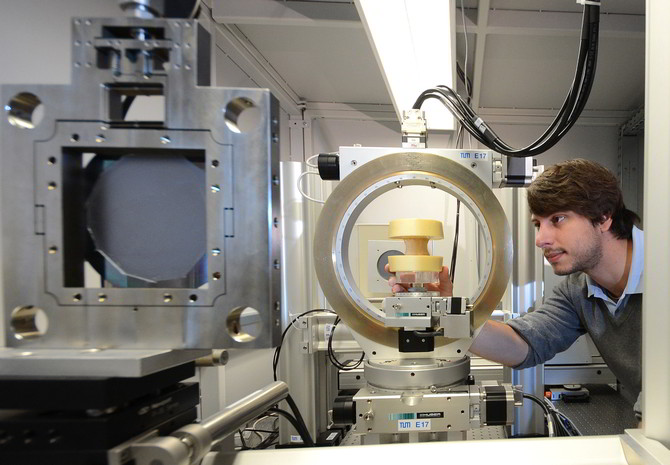Biomedical Engineering and Medical Physics

The areas of Biomedical Engineering and Medical Physics at TUM are focused on the improvement and development of novel imaging modalities for microscopy and biomedical imaging as well as on the development of biosensor technology for Lab-On-Chip technology. Other examples include the application of artificial intelligence for the analysis of medical data, the improvement of therapeutic methods, the development of tracers or methods to support radiotherapy, as well as various biomedical applications of biomechanics and biophysics to the broad field of biomedical engineering.
The courses on the Biomedical Engineering and Medical Physics Master teaches the basics and the skills required to successfully carry out research or industrial projects across the interdisciplinary boundaries between natural sciences, engineering and medicine. In addition to the necessary background knowledge and practical know-how, the self and social skills required in the academic or industrial environment of biomedical engineering should also be promoted. This profile is intended to enable graduates to be deployed in a wide range of industrial and service industries. Typical fields of application for the graduates of this master's program are in experimental research activities, in the planning and documentation of research projects as well as in adjacent fields of activity of the biotech and medical technology industry, for example in patenting, development, project planning or in public institutions.
The research area of the Biomedical Engineering and Medical Physics Master at TUM covers almost all aspects of this modern and highly interdisciplinary field of research with numerous internationally networked working groups from physics, computer science, engineering, life sciences and medicine. The research ranges from the development of novel X-ray imaging and the improvement of magnetic resonance imaging to the development of efficient biosensors. Throughout Germany, TUM is uniquely positioned in the field of biomedical engineering.
The Biomedical Engineering and Medical Physics master's program is designed for a two-year period in which students will experience research related training at the interface between natural sciences, engineering and medicine, and gain early insight into current research at the highest international level.
Specialization Areas
Students can specialize in the following areas:
- biomedical imaging
- biosensors
which are a reflection of our research expertise.
Examples of Study Plans
The study program of the first year of studies can be organized individually. A mentor can give you advice in choosing the specific courses. If you are interested in a given research area, it may be helpful to choose a mentor working in it (e.g. see the lecturers of the courses). The second year with the research phase is structured identically for all focus areas and hence omitted in the tables below.
Focus on Imaging
Students with an interest in Imaging may for example choose a study plan like the following:
| Modules | Cycle | CP |
|---|---|---|
| Basic Modules | ||
| PH2001 Biomedical Physics 1 | WS | 5 |
| PH2002 Biomedical Physics 2 | SS | 5 |
| Focus Areas | ||
| PH2226 Chemistry in Biomedical Imaging for Physicists | WS | 5 |
| PH2270 Physics of Magnetic Resonance Imaging 1 | WS | 5 |
| PH2013 Physical Biology of the Cell 1 | WS | 5 |
| IN2021 Computer Aided Medical Procedures | WS | 5 |
| PH2251 Techniques and Data Analysis in Biophysics 1 | WS | 5 |
| PH2182 Modern X-Ray Physics | SS | 5 |
| PH2181 Image Processing in Physics | SS | 5 |
| PH2271 Physics of Magnetic Resonance Imaging 2 | SS | 5 |
| General-Education subjects and Lab Course | ||
| PH8116 Writing Scientific Papers: English Writing for Physics | SS | 4 |
| Fortgeschrittenenpraktikum Biomedical Engineering and Medical Physics | SS | 6 |
Focus on Biosensors
Students with an interest in Biosensors may for example choose a study plan like the following:
| Modules | Cycle | CP |
|---|---|---|
| Basic Modules | ||
| PH2001 Biomedical Physics 1 | WS | 5 |
| PH2002 Biomedical Physics 2 | SS | 5 |
| Focus Areas | ||
| EI7473 BioMEMS and Microfluidics | WS | 5 |
| EI71031 Biomedical Engineering – Diagnostics and Clinical Correlations | WS | 5 |
| PH2013 Physical Biology of the Cell 1 | WS | 5 |
| IN2021 Computer Aided Medical Procedures | WS | 5 |
| MW1948 Experimental Techniques for the Characterization of Biomatter | WS | 5 |
| PH2182 Modern X-Ray Physics | SS | 5 |
| EI71032 In Vitro Diagnostik | SS | 5 |
| PH2014 Physical Biology of the Cell 2 | SS | 5 |
| General-Education subjects and Lab Course | ||
| PH8116 Writing Scientific Papers: English Writing for Physics | SS | 4 |
| Fortgeschrittenenpraktikum Biomedical Engineering and Medical Physics | SS | 6 |
Individual Focus
| Modules | Cycle | CP |
|---|---|---|
| Basic Modules | ||
| PH2001 Biomedical Physics 1 | WS | 5 |
| PH2002 Biomedical Physics 2 | SS | 5 |
| Focus Areas | ||
| Catalog, Counseling by mentor | WS/SS | 40 |
| General-Education subjects and Lab Course | ||
| Catalog, Counseling by mentor | WS/SS | 4 |
| Fortgeschrittenenpraktikum Biomedical Engineering and Medical Physics | SS | 6 |